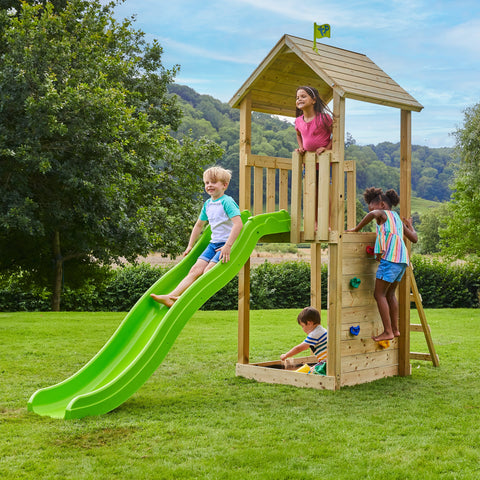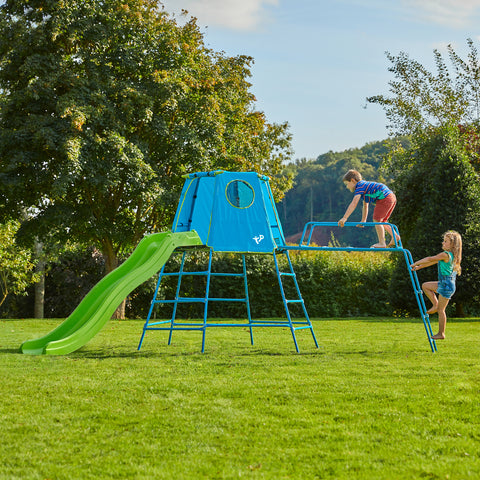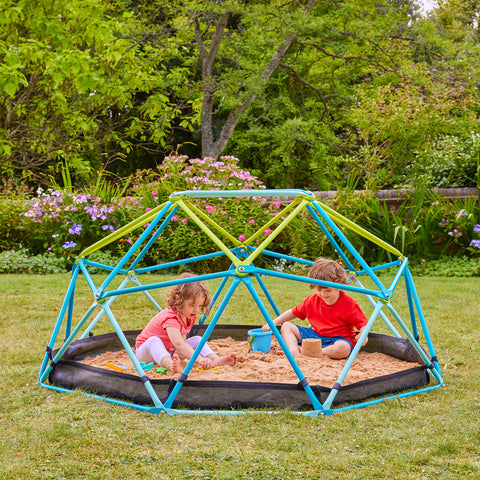Climbing frames are more than just play structures; they're gateways to adventure and exploration for young adventurers. However, making sure young children stay safe while they scale these structures is vital. In this comprehensive guide, we'll look into the essential safety features to consider when choosing climbing frames, ensuring that fun and safety go hand in hand. We'll explore material and construction considerations, safety certifications, age-appropriate design elements and more, so that parents and caregivers have all the knowledge they need to create a secure and stimulating play environment for their children.

Essential Safety Features
- Fall Protection: Look for kids climbing frames equipped with appropriate fall protection measures, such as safety nets, guardrails, and soft landing surfaces. These features provide an important line of defence against potential falls, giving parents peace of mind while children engage in active play.
- Sturdy Construction: Opt for climbing frames made from high-quality materials and sturdy construction techniques. Solid wood frames or robust metal structures offer durability and stability, ensuring that the climbing frame can take even the most enthusiastic play in its stride.
- Certifications: Check that your chosen climbing frame either meets or better yet exceeds safety standards and certifications. Look for options that comply with recognised safety guidelines, such as EN 1176 for playground equipment in Europe or ASTM International standards in the United States. These certifications show that the climbing frame has undergone rigorous testing to ensure its safety and reliability.
- Age-Appropriate Design: Choose a climbing frame that is suitable for the age and developmental stage of the intended users. Features such as low platforms, wide steps, and age-appropriate challenges promote safe and enjoyable play experiences while promoting physical and cognitive development.
Material and Construction Considerations
Wooden Climbing Frames- Wooden climbing frames are a popular choice for their natural aesthetic and durability. When picking out a wooden climbing frame, make sure that the wood is treated for outdoor use so it will be resistant to rot and decay. Regular maintenance, such as staining or sealing, can help make the structure last longer and maintain its strength.
- Outdoor Treatment: Ensure that the wood used in the climbing frame has been treated for outdoor use. Outdoor-treated wood is resistant to moisture, rot, and decay, which will help the structure to last longer and will help to maintain its strength even in harsh weather conditions.
- Regular Maintenance: Performing regular maintenance is essential to keep wooden climbing frames in top condition. Apply a weather-resistant sealant or stain to protect the wood from UV rays, moisture, and fungal growth.
- Structural Stability: Ensure that the wooden climbing frame is structurally stable and securely anchored to the ground. Check for sturdy construction, including reinforced joints and braces, to withstand the weight and movement of active children.
Metal Structures

- Metal climbing frames are very strong and stable, making them suitable for more adventurous play. Look for climbing frames made from galvanised or powder-coated steel, which protects against rust and corrosion. Smooth, rounded edges and welded joints are safer as they reduce the risk of injury.
- Quality of Materials: Look for climbing frames made from high-quality materials such as galvanised or powder-coated steel. Galvanising provides a protective zinc coating that helps prevent rust and corrosion, which will help the climbing frame last longer and stay structurally sound.
- Smooth, Rounded Edges: Smooth, rounded edges help to reduce the risk of cuts, scrapes, and other injuries that can happen during play. Inspect the climbing frame for any sharp edges or bolts that stick out which could pose a safety hazard, and fix any issues before allowing children to use the structure.
- Welded Joints: Welded joints are much stronger and more stable compared to joints with bolts or screws. Choosing a metal climbing frame with sturdy welded joints will remain strong and sturdy even during the most enthusiastic play without compromising safety.
By taking into account these material and construction options when choosing a climbing frame, parents and caregivers can ensure that their children enjoy safe and enjoyable outdoor play for years to come. Whether you opt for a wooden or metal climbing frame, its durability, stability, and safety features should always be the main considerations for a secure and inviting play environment for children to explore and grow.
Design Elements for Safety and Fun
- Geometric Shapes: Incorporating geometric shapes and patterns into the design of the climbing frame will help to stimulate children's spatial awareness and problem-solving skills. Features such as angled platforms, climbing walls, and tunnels encourage exploration and imaginative play while aiding physical development.
- Negative Space: Build negative space into the design of the climbing frame to create challenging and dynamic play opportunities. Open spaces between bars or platforms encourage climbers to navigate obstacles and will help to develop balance and coordination.

Considerations for Age and Development
- Age-Appropriate Challenges: Tailor the design of the climbing frame to provide age-appropriate challenges and opportunities for skill development. For young children, focus on low platforms, gentle slopes, and simple climbing structures that will build confidence and physical strength. Older children may enjoy more challenging features like monkey bars, rope bridges, and climbing walls that help to develop their agility and coordination.
- Imaginative Play: Encourage imaginative play and creativity by incorporating themed elements into the climbing frame design. From pirate ships to jungle adventures, themed climbing frames spark children's imaginations and inspire role-playing and storytelling while they explore and conquer new challenges.
Conclusion
Choosing a safe climbing frame involves careful assessment of essential safety features, construction materials, design elements, and age-appropriate considerations. By prioritising safety without compromising on fun and adventure, parents and caregivers can create a stimulating and secure play environment for young climbers. With the right climbing frame, children can develop physical strength, spatial awareness, and problem-solving skills while enjoying countless hours of active play and exploration.





